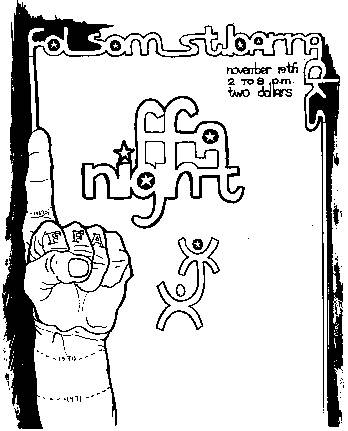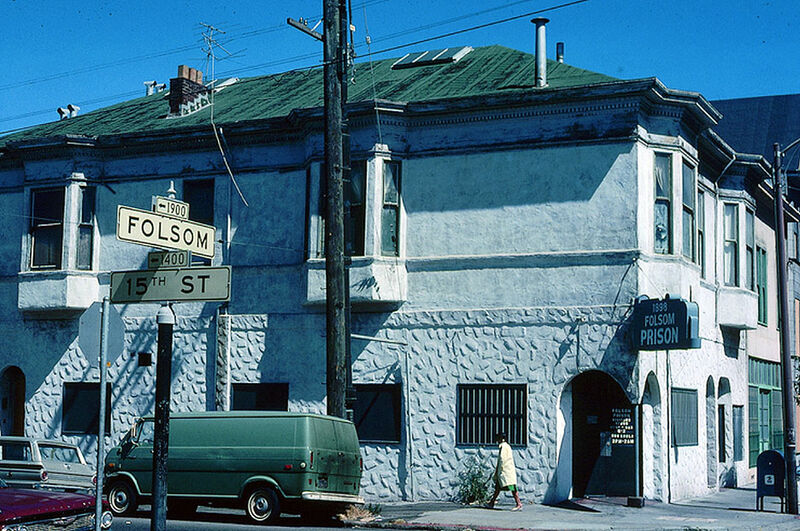Coming Out into the 1970s: Difference between revisions
(PC and protected) |
(added lost landscapes video) |
||
| (8 intermediate revisions by 2 users not shown) | |||
| Line 3: | Line 3: | ||
''by Bill Brent'' | ''by Bill Brent'' | ||
[[Image: | [[Image:Gay Freedom Day 1976 Gaar wnp72.085.jpg|800px]] | ||
''' | '''Gay Freedom Day in 1974, when the gay community was equally focused on the Polk Gulch area, as seen in this photo taken on Polk near O'Farrell.''' | ||
''Photo: OpenSFHistory.org wnp72.085; © Greg Gaar Photography'' | |||
[[Image:Polk Street Fair at Polk and Pine 1975 opensfhistory wnp25.4818.jpg|800px]] | |||
'''Polk Street Fair at Polk and Pine in 1975.''' | |||
''Photo: OpenSFHistory.org wnp25.4818'' | |||
<Blockquote>"After Stonewall, we started coming out from everywhere and converging in San Francisco. And what you had were thousands of young men, who were suddenly liberated from these old restrictions. They'd been hearing all their lives that they were sick, twisted, criminal, sinful, depraved, and, you know, they couldn't do what they most wanted to do. And then they got a clue, there's something going on in San Francisco, and they came they liberated themselves sexually. I think there's a lot more in terms of culture and spirituality that they weren't really grasping. For them, being gay was all about fucking and sucking. Now we have a much more sophisticated understanding that sexuality is very much involved with spirituality, and politics, and culture. Basically, we've grown up. Back in those days, we had all these guys who were having this explosive adolescent surge of new-found erotic freedom which unleashed this creative explosion, too. But it was all entirely new. | |||
Everything was fresh and new. None of this had been done before!"</blockquote> | |||
[[Image:2-women-and-2-men Party-2.jpg]] | |||
'''Snapshot from a house party in the Castro in the 1970s.''' | |||
''Photo: Christa Mae'' | |||
<iframe src="https://archive.org/embed/gay-freedom-day-1970s-llsf-2016-20-mbps" width="640" height="480" frameborder="0" webkitallowfullscreen="true" mozallowfullscreen="true" allowfullscreen></iframe> | |||
'''Home movie footage of early Gay Freedom parade on O'Farrell Street, probably 1972.''' | |||
''Video: from "Lost Landscapes 11" courtesy Prelinger Archives'' | |||
By the early '70s, several different gay cultures were developing within the City. Gay columnists of the period were surprised but delighted by the emergence of the Castro Street area as a gathering spot for gay culture. There was fluidity between the neighborhoods and between the emerging gay cultures. And several cultures could find a home in the same gay male soul. As a group, gay men are consummate chameleons, reinventing themselves at will. This is a survival skill honed from necessity in a world hostile to queer visibility. For instance, a gay man could don glitter drag inspired by gay theatre groups like the Cockettes and the Angels of Light. The next night he might "butch it up" in leather drag to go prowling along Folsom. This worked, as long as he wore the right outfit to the right place. | By the early '70s, several different gay cultures were developing within the City. Gay columnists of the period were surprised but delighted by the emergence of the Castro Street area as a gathering spot for gay culture. There was fluidity between the neighborhoods and between the emerging gay cultures. And several cultures could find a home in the same gay male soul. As a group, gay men are consummate chameleons, reinventing themselves at will. This is a survival skill honed from necessity in a world hostile to queer visibility. For instance, a gay man could don glitter drag inspired by gay theatre groups like the [[Cockettes|Cockettes]] and the Angels of Light. The next night he might "butch it up" in leather drag to go prowling along Folsom. This worked, as long as he wore the right outfit to the right place. | ||
Jack Fertig recalls, "I was living in genderfuck drag in Berkeley in '72. We got up into drag and came into the City. We were just checking out the bars on Folsom Street that we'd heard about. We tried getting into the Ramrod, but they wouldn't allow us in because we didn't fit the dress code, which was sort of black. They said, 'Sorry, girls! You gotta dress butch to come in here.'" | Jack Fertig recalls, "I was living in genderfuck drag in Berkeley in '72. We got up into drag and came into the City. We were just checking out the bars on Folsom Street that we'd heard about. We tried getting into the Ramrod, but they wouldn't allow us in because we didn't fit the dress code, which was sort of black. They said, 'Sorry, girls! You gotta dress butch to come in here.'" | ||
[[Image:gay1$ffa-flyer.jpg|left]] | |||
'''Fistfucking "timeline"--poster for Fist Fuckers of America (FFA) night at the Folsom Street Barracks, c. 1972''' | |||
The bars South of Market were the places where leathermen could exist on their own terms by controlling who was admitted and under what conditions. The street outside was a world away. Yet in another sense, the street was equally important in forming their queer identity, for the street was where queers were confronted with the norms of heterosexual society. In ''Some Dance to Remember'', Jack Fritscher writes: "When gay people liberated themselves at the Stonewall riot, they shouted, 'Out of the bars and into the streets.' The street is a confirmation of the public side of gay life and politics. The street is the place where, when you go there, you know you're out of your closet." | The bars South of Market were the places where leathermen could exist on their own terms by controlling who was admitted and under what conditions. The street outside was a world away. Yet in another sense, the street was equally important in forming their queer identity, for the street was where queers were confronted with the norms of heterosexual society. In ''Some Dance to Remember'', Jack Fritscher writes: "When gay people liberated themselves at the Stonewall riot, they shouted, 'Out of the bars and into the streets.' The street is a confirmation of the public side of gay life and politics. The street is the place where, when you go there, you know you're out of your closet." | ||
[[Image:Folsom-Prison,-a-gay-bar,-at-1898-Folsom-Street-at-15th-Street---1976-.jpg|800px]] | |||
'''Folsom Prison, a gay bar at 1898 Folsom Street at 15th Street, 1976.''' | |||
''Photo: Max Kirkeberg Collection, diva.sfsu.edu'' | |||
''Originally published in ''Black Sheets'' magazine '' | |||
| Line 23: | Line 55: | ||
[[The 1970s: Disco Fever and Respectability | Prev. Document]] [[Sex Panic Closes Bathhouses | Next Document]] | [[The 1970s: Disco Fever and Respectability | Prev. Document]] [[Sex Panic Closes Bathhouses | Next Document]] | ||
[[category: | [[category:LGBTQI]] [[category:Castro]] [[category:SOMA]] [[category:1970s]] [[category:Polk Gulch]] [[category:Mission]] | ||
Latest revision as of 21:29, 2 November 2023
Historical Essay
by Bill Brent
Gay Freedom Day in 1974, when the gay community was equally focused on the Polk Gulch area, as seen in this photo taken on Polk near O'Farrell.
Photo: OpenSFHistory.org wnp72.085; © Greg Gaar Photography
Polk Street Fair at Polk and Pine in 1975.
Photo: OpenSFHistory.org wnp25.4818
"After Stonewall, we started coming out from everywhere and converging in San Francisco. And what you had were thousands of young men, who were suddenly liberated from these old restrictions. They'd been hearing all their lives that they were sick, twisted, criminal, sinful, depraved, and, you know, they couldn't do what they most wanted to do. And then they got a clue, there's something going on in San Francisco, and they came they liberated themselves sexually. I think there's a lot more in terms of culture and spirituality that they weren't really grasping. For them, being gay was all about fucking and sucking. Now we have a much more sophisticated understanding that sexuality is very much involved with spirituality, and politics, and culture. Basically, we've grown up. Back in those days, we had all these guys who were having this explosive adolescent surge of new-found erotic freedom which unleashed this creative explosion, too. But it was all entirely new. Everything was fresh and new. None of this had been done before!"
Snapshot from a house party in the Castro in the 1970s.
Photo: Christa Mae
<iframe src="https://archive.org/embed/gay-freedom-day-1970s-llsf-2016-20-mbps" width="640" height="480" frameborder="0" webkitallowfullscreen="true" mozallowfullscreen="true" allowfullscreen></iframe>
Home movie footage of early Gay Freedom parade on O'Farrell Street, probably 1972.
Video: from "Lost Landscapes 11" courtesy Prelinger Archives
By the early '70s, several different gay cultures were developing within the City. Gay columnists of the period were surprised but delighted by the emergence of the Castro Street area as a gathering spot for gay culture. There was fluidity between the neighborhoods and between the emerging gay cultures. And several cultures could find a home in the same gay male soul. As a group, gay men are consummate chameleons, reinventing themselves at will. This is a survival skill honed from necessity in a world hostile to queer visibility. For instance, a gay man could don glitter drag inspired by gay theatre groups like the Cockettes and the Angels of Light. The next night he might "butch it up" in leather drag to go prowling along Folsom. This worked, as long as he wore the right outfit to the right place.
Jack Fertig recalls, "I was living in genderfuck drag in Berkeley in '72. We got up into drag and came into the City. We were just checking out the bars on Folsom Street that we'd heard about. We tried getting into the Ramrod, but they wouldn't allow us in because we didn't fit the dress code, which was sort of black. They said, 'Sorry, girls! You gotta dress butch to come in here.'"
Fistfucking "timeline"--poster for Fist Fuckers of America (FFA) night at the Folsom Street Barracks, c. 1972
The bars South of Market were the places where leathermen could exist on their own terms by controlling who was admitted and under what conditions. The street outside was a world away. Yet in another sense, the street was equally important in forming their queer identity, for the street was where queers were confronted with the norms of heterosexual society. In Some Dance to Remember, Jack Fritscher writes: "When gay people liberated themselves at the Stonewall riot, they shouted, 'Out of the bars and into the streets.' The street is a confirmation of the public side of gay life and politics. The street is the place where, when you go there, you know you're out of your closet."
Folsom Prison, a gay bar at 1898 Folsom Street at 15th Street, 1976.
Photo: Max Kirkeberg Collection, diva.sfsu.edu
Originally published in Black Sheets magazine





